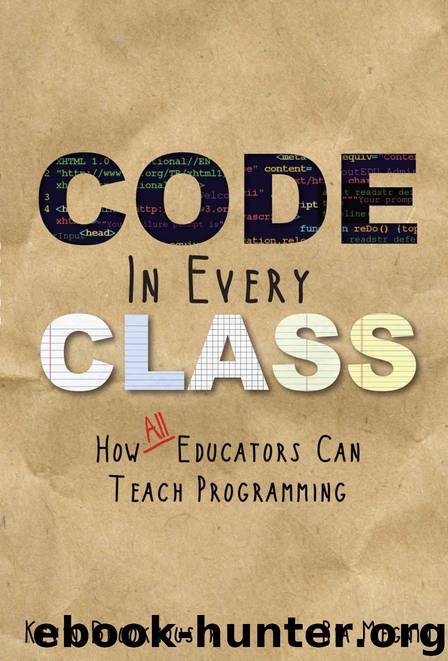Code in Every Class: How All Educators Can Teach Programming by Kevin Brookhouser & Ria Megnin

Author:Kevin Brookhouser & Ria Megnin
Language: eng
Format: azw3, epub
ISBN: 9781945167225
Publisher: EdTechTeam Press
Published: 2017-01-08T08:00:00+00:00
Goals, including intended learning outcomes
Brief description of project
Timeline
Team members
Any necessary supplies or administrative support
Successful examples of models from other districts
Let’s look at some of the common concerns you can address to keep administrators on your side.
“Gotta Meet the Standards”
When it comes to our international obsession with standardized testing, teachers aren’t the only ones who have it rough. School administrators know if students don’t perform well on tests, entire districts will face serious consequences, up to and including a state takeover. So you’ll have to demonstrate time spent coding won’t hurt student performance on upcoming tests.
Fortunately, this is easy. We already know, with a little creativity, learning coding can actually improve test performance. (No — not by teaching kids to hack the testing software, as tempting as it may be!) Refer to “Misconception #4: Coding doesn’t fit the mandatory curriculum or standardized testing regimen” in Chapter 1. In short, computer science teaches general skills — logical thinking, making connections across lessons, data organization, persistence — to help with test taking. Lessons using coding can help students engage content more deeply and actively.
For instance, a fourth-grade class could use spreadsheets to sort and compare the who, what, when, where, and why of stories they’ve been reading. An eleventh grade history class could use animation software and mapping tools to show how a region’s political boundaries changed over time. These approaches help students make connections across multiple lessons and topics, and increases the likelihood they’ll remember the content for later testing.
Jared Amalong, who teaches in Placer County, California, shared this example:
Starting in 2008, I was fortunate to have administrators willing to give a county-wide computer science capstone course a try — and it was a success! Because of its applied nature, even students new to programming immersed themselves in the course and integrated their experience with other academic subjects. One former student, Bradley, extended his efforts in my course to his physics course, where he wrote many small programs to solve the challenging problems presented to him.
In conversations with his parents and teachers, I learned Bradley’s commitment to computer science renewed his commitment to his other academic studies. Bradley is now a computer science major in college and has begun applying his studies in an internship with LinkedIn. His story — like those of many other former students — demonstrates computer science is a model twenty-first century curricula as it prepared him for both college and career.
Download
Code in Every Class: How All Educators Can Teach Programming by Kevin Brookhouser & Ria Megnin.epub
This site does not store any files on its server. We only index and link to content provided by other sites. Please contact the content providers to delete copyright contents if any and email us, we'll remove relevant links or contents immediately.
The Art of Coaching Workbook by Elena Aguilar(50039)
Trainspotting by Irvine Welsh(20944)
Twilight of the Idols With the Antichrist and Ecce Homo by Friedrich Nietzsche(18266)
Fangirl by Rainbow Rowell(8756)
Periodization Training for Sports by Tudor Bompa(7889)
Change Your Questions, Change Your Life by Marilee Adams(7321)
This Is How You Lose Her by Junot Diaz(6401)
Asking the Right Questions: A Guide to Critical Thinking by M. Neil Browne & Stuart M. Keeley(5320)
Grit by Angela Duckworth(5262)
Red Sparrow by Jason Matthews(5167)
Paper Towns by Green John(4753)
Room 212 by Kate Stewart(4703)
Ken Follett - World without end by Ken Follett(4411)
The Sports Rules Book by Human Kinetics(4045)
Housekeeping by Marilynne Robinson(4016)
Double Down (Diary of a Wimpy Kid Book 11) by Jeff Kinney(3874)
Papillon (English) by Henri Charrière(3870)
The Motorcycle Diaries by Ernesto Che Guevara(3754)
Exercise Technique Manual for Resistance Training by National Strength & Conditioning Association(3754)
